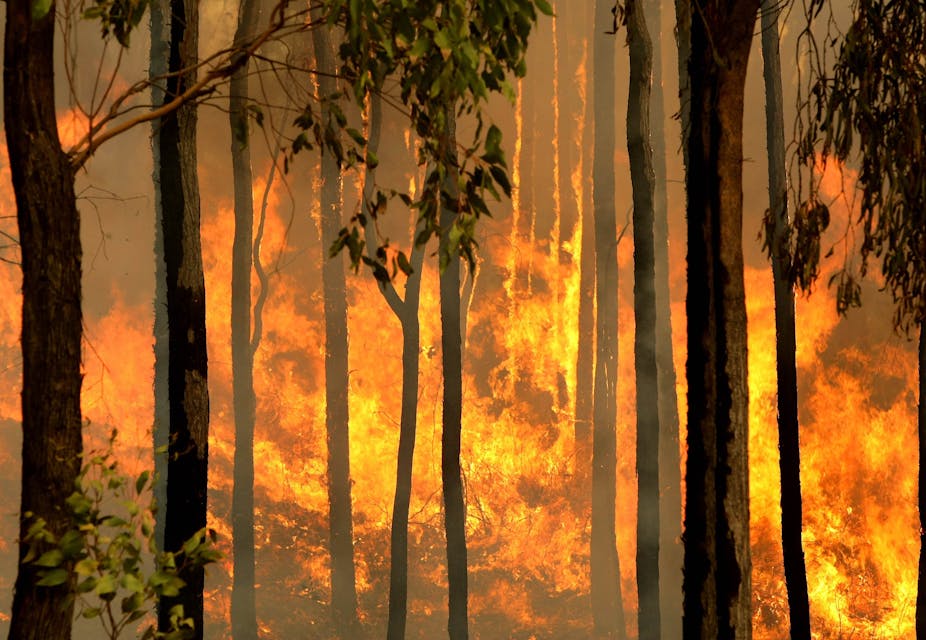Bushfires are part of the Australian landscape and the psyche of its human inhabitants. This is particularly true as months of hot, dry weather approach.
Recent warnings have predicted a dire summer ahead with the potential for major fires across the continent.
So will this year’s fire season be particularly bad? What are the different types of bushfire activity found across our continent? And how can these bushfire types help us predict how climate change will affect future fire seasons?
More rain = more fire
Last year, floods and high rainfall affected many regions of the continent, including large tracts of the dry interior.
A wet year, following extended dry spells, has resulted in rapid growth of grasses and herbs. This leaves a relatively dense and continuous layer of ground cover blanketing what is often bare ground.
Such conditions are the precursor to major fires, particularly as herbaceous ground cover begins to dry or “cure”. Once cured it is then available as fuel to burn.
In other years we’ve heard warnings but for different reasons. During the major droughts of recent years, warnings of a “horror” fire season were targeted at the forests that fringe our coastline, particularly in the temperate south where most Australians live.
These are our wettest environments and where plant growth or “productivity” is high. The relatively dense cover of trees, shrubs and grasses in forests provides an ever-present fuel layer of ground litter: it’s mainly the fallen leaves of trees and shrubs.
For much of the year, these litter fuels are unavailable to burn (they are too wet). But periodic, prolonged and widespread droughts dry this fuel enough that fires can readily ignite and spread.
Such circumstances – as in 2003 and 2009 – can result in fires that cause major losses of life and property on the margins of our largest cities and towns.
It’s not what starts fires, but what usually stops them
Most years, fires don’t happen because there is something stopping them. We call these things “key limitations”. When limitations break down, fire takes hold.
Where fire follows rain, as in dry ecosystems, the mass of fuel is normally too low and patchy to enable fires to spread. In wet years this limitation is overcome, as often-dormant plants start to grow.
By contrast, in our relatively moist, productive ecosystems, fuel mass and continuity is normally sufficient for fires to spread but is otherwise too wet for fires to take hold. Prolonged, extensive dry spells are needed to overcome this limitation.
In the dry country, big wet years typically occur a decade or more apart, with exceptional, extensive years – such as 2011 – occurring less frequently.
In wetter forests, major drought may occur as often as twice a decade. In cooler regions, droughts may be a decade or more apart.

Up north, there are no limits
These patterns aren’t the same across the whole country. Across northern Australia’s vast, tropical savanna woodlands, conditions for fire are ideal.
The tropical grasses of these woodlands have a prolific surge of growth in response to the deluge of the wet season, providing extensive fuel every year. The ensuing six-month dry season that follows without fail, ensures this fuel is fully cured.
At the climax of the dry season, when people in Sydney and Melbourne are shivering in late winter, fire activity in the tropical north is reaching its climax under the influence of hot dry trade-winds. Up north, major fires happen annually, in contrast to other ecosystems where the right conditions occur less often.
Consequently, the average annual area burned across the top end of Australia dwarfs that which occurs elsewhere.
Our continent therefore has differing natural fire rhythms. These reflect the underlying patterns of climate and weather and the types of plants that grow in response to these conditions.
What does this mean for fire management?
From day to day, managers of land and fire need the ability to monitor the key processes that bring their local landscape into a state where it is ready to burn.
Many initiatives – such as using satellites to monitor the growth and drying of vegetation and the resultant perimeters and patterns of burning – are pivotal to this task.
Ongoing scientific research provides key insights and management tools for this purpose.

In the longer term, and where the primary limitation on fire is the availability of dry fuel to burn, warming and drying may mean more fires. Where the limiting factor is the lack of sufficient surface fuel, such as in many arid regions, warming and drying may mean less fire.
Given that most of the continent is dry, fire could recede across much of it in coming decades. But fire could also increase in environments where human exposure is greatest and most vulnerable (that is, the forested margins of our capital cities).
There are many complications and variants to this scenario. For one, plant growth and its rate of drying are not solely affected by these direct effects of future climate.
Fire in the future will also be influenced by a complex array of other processes, such as effects of elevated atmospheric CO₂ on plant growth, invasive drought resistant grasses, patterns of land clearing and altered rates of ignition due to changes in lightning and human populations.
These possibilities make it difficult to predict future directions. Getting a base-line understanding of how fires work in different local areas is the first step toward meeting this challenge.

